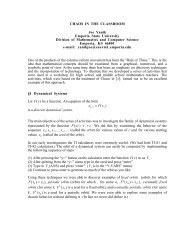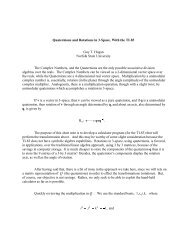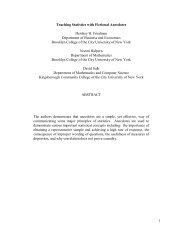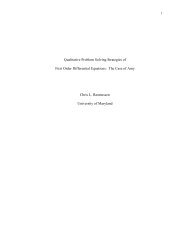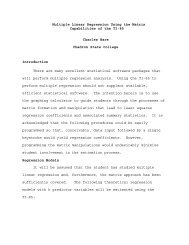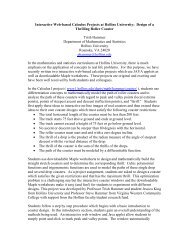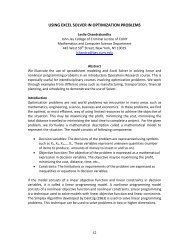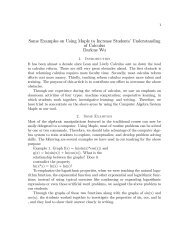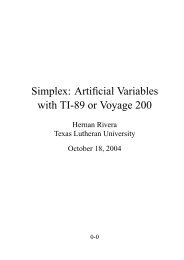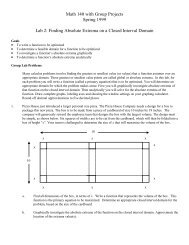CONNECTING GEOMETRY, MEASUREMENT, AND ALGEBRA ...
CONNECTING GEOMETRY, MEASUREMENT, AND ALGEBRA ...
CONNECTING GEOMETRY, MEASUREMENT, AND ALGEBRA ...
You also want an ePaper? Increase the reach of your titles
YUMPU automatically turns print PDFs into web optimized ePapers that Google loves.
Übersicht• Der Carbon-Hype• Was ist Leichtbau ?• Mikroskopischer Aufbau• Das Problem der Verbindung• Konstruktive Eigenarten• Fertigung und Bauteile• Wie geht es weiter ?28.11.2012 Seite 2
Connections in Teaching MathematicsHow can a teacher use the practice of reflection to create rich mathematical learningenvironments that are engaging to students? In such environments, one can hear and see aseamless integration of Problem Solving, Reasoning and Proof, Communication, makingMathematical Connections, and Representation (NCTM Process Standards, 2000)through Number and Operations, Algebra, Geometry, Measurement, and Data Analysisand Probability. While the five Content Standards are the heart of the curriculum, theProcess Standards are essential to keeping it flowing. If the Mathematics ContentStandards are "what" teachers teach, the Process Standards are "how" teachers teach itand how students learn it. Although the Process Standards are a required part of the statecurriculum, many teachers need ways to make sense of them within the context of theirteaching.Connections between the Common Core State Standards and the National Council ofTeachers of Mathematics (NCTM) Standards need to meet the challenges ofdifferentiating mathematics instruction in the K-8 classroom. Small (2012) explains twopowerful and universal strategies that teachers can use across all math content: OpenQuestions and Parallel Tasks. Showing teachers how to get started and become expertswith these connection strategies, Small also demonstrates more inclusive learningconversations that promote broader student participation and mathematical thinking.Guidance for creating a more inclusive classroom learning community with mathematicaltalk that engages participants from all levels is important (Small, 2012). While using thetechnology and covering all the required math standards by making all necessaryconnections for sound learning, students can work together and use the software toengage in higher level mathematical understanding.Andresen & Misfeldt (2010) found that with the new Common Core Standards (NationalGovernors Association Center for Best Practices - NGA Center, 2010) in teachingmathematics, teachers need to be trained and learn new mathematics content andtechnology like GeoGebra in order to be effective in teaching and reaching their students.Knowledge of technology cannot be isolated from the content and good mathematicsteaching requires an understanding on how technology is related to the pedagogy andmathematics (Hughes, 2005).Today, most schools and states are adhering to the new Common Core Math Standards(National Governors Association Center for Best Practices (NGA Center) and theCouncil of Chief State School Officers (CCSSO), 2010) found at:http://www.corestandards.org/. A sampling of objectives from the new Common CoreStandards that can be addressed using the GeoGebra software follows.Grade 3A Look at the New Common Core StandardsCommon Core Math Standards http://www.corestandards.org/66
3.G.1. Understand that shapes in different categories (e.g., rhombuses, rectangles,and others) may share attributes (e.g., having four sides), and that theshared attributes can define a larger category (e.g., quadrilaterals).Recognize rhombuses, rectangles, and squares as examples ofquadrilaterals, and draw examples of quadrilaterals that do not belong toany of these subcategories.3.G.2. Partition shapes into parts with equal areas. Express the area of each part asa unit fraction of the whole. For example, partition a shape into 4 parts withequal area, and describe the area of each part as 1/4 of the area of the shape.Grades 66.G.1. Find the area of right triangles, other triangles, special quadrilaterals, andpolygons by composing into rectangles or decomposing into triangles andother shapes; apply these techniques in the context of solving real-worldand mathematical problems.6.G.3. Draw polygons in the coordinate plane given coordinates for the vertices;use coordinates to find the length of a side joining points with the samefirst coordinate or the same second coordinate. Apply these techniques inthe context of solving real-world and mathematical problems.Levels of Understanding New Concepts1. Start with the Concrete using hands-on manipulatives, like Geoboards2. Move to Representational models in diagrams, like pictures of VirtualManipulatives3. Lastly, connect to the Abstract symbolism where student understand and functionat an abstract level completely connecting geometry, measurement, and algebrawhen using GeoGebra.NCTM has advocated problem solving as the central theme of the math curriculum formany years now (NCTM, 1989, 2000, 2006). In order to accomplish the Common CoreStandards, the authors believe that students should use GeoGebra to simulate and solveword problems and explore conjectures that lead to formulas and theorems. By workingin groups or alone, students explore weekly problems by using the GeoGebra software toshow their true understanding of the math concepts in a representational manner. WithGeoGebra covering many of the new Common Core Math Standards, it lends itself wellto learn and connect many geometry, measurement, and algebra standards and concepts.An Example Math Problem using Geometry, Measurement, & AlgebraExample Word Problem which can be modeled in GeoGebra:On Japanese trains, there is a rule that forbids passengers bringing onto the train objectslonger than 36 inches. How did a passenger travel with a ceremonial sword that was 42inches long? Discuss strategies and solutions (See Appendix C).67
Today it is critical that as teachers, we connect the geometry and measurement integratedwith algebra to better prepare them for higher level mathematics. Connections andtechnology are both critical aspects for learning mathematics and part of NCTM’sprinciples for teaching mathematics (2000, 2006). Everything that is geometric we wantto measure. All measurements can by synthesized into formulas that use algebra andalgebraic expressions. While motivating students in learning mathematics, educatorsmust make these connections. When using software like GeoGebra, it is much easiermaking the connections. The Appendices offer many other suggested GeoGebra activitiesand other mathematical connections/resources that can be used by classroom mathteachers.SummarySo why should elementary mathematics teachers use GeoGebra in their classrooms toteach mathematics? The first reason is because it is free to download and use, one can goto GeoGebra.org. GeoGebra is an up and coming dynamic teaching tool in our schoolstoday. It is user-friendly for students and teachers. To connect geometry, measurement,and algebra to each other using the software, as students draw shapes, they can thenmeasure them, and then derive formulas using the “Algebra View” to see such formulas.If math anxiety occurs frequently, then attention to effective teaching methods thatovercome math anxiety are important. Teachers need to use best practices likeincorporating technology like GeoGebra into math instruction.GeoGebra can be used as a dynamic and interactive learning tool that will preparestudents for future abstract mathematical concepts. When building a strong foundation ingeometry, algebra, and measurement, primary-aged students find it fun and easy-to-use.Students may move from using the geoboards, to the virtual geoboards, then finally toGeoGebra. When the grid view is turned on, they can see GeoGebra as an extension ofthe geoboard. When elementary teachers use GeoGebra with students, it is suggested thatthey leave the grid on the screen and turn off the Algebra View tool to minimize studentconfusion.In a globally competitive world where it is more important to prepare our students for thescience, technology, engineering, and mathematics (STEM) fields, using this softwarecovers all. It applies math, science, and engineering ideas while using and applying thetechnology. Sparks (2011) feels that as the STEM fields become more important for ourstudents to study, our schools and teachers need to do more to address math anxiety sothat our students are confident to study areas related to STEM.PowerPoint and Data Files for GeoGebra as they relate to this presentation and paper canbe accessed at: http://matharoundus.com/GeoGebra. See Appendices A, B, and C foradditional resources and examples for using GeoGebra.68
ReferencesAndresen, M., & Misfeldt, M. (2010). Essentials of teacher training sessions withGeoGebra. International Journal for Technology in Mathematics Education,17(4), 169-176.Fahlberg-Stojanovska, L, & Stojanovski, V. (2009). Geogebra- freedom to explore andlearn. Teaching Mathematics and Its Applications: An International Journal ofthe IMA, 28(2).Furner, J. M., & Marinas, C. A. (2007). Geometry sketching software for elementarychildren: Easy as 1, 2, 3. Eurasia Journal of Mathematics, Science & TechnologyEducation, 3(1), pp. 83-91.Hohenwarter, J., Hohenwarter, M., and Lavicza, Z. (2009). Introducing dynamicmathematics software to secondary school teachers: The case of GeoGebra. TheJournal of Computers in Mathematics and Science Teaching, 28(2), 135-46.Hughes, J. (2005). The role of teacher knowledge and learning experiences in formingtechnology-integrated pedagogy. Journal of Technology and Teacher Education,13(2), 277–302.National Council of Teachers of Mathematics. (2006). Curriculum focal points forprekindergarten through grade 8 mathematics: a quest for coherence. Reston,VA.:Author.National Council of Teachers of Mathematics. (2000). Principles and Standards forSchool Mathematics. Reston, VA: Author.National Council of Teachers of Mathematics. (1989). Curriculum & EvaluationStandards. Reston, VA: NCTM.National Educational Technology Standards for Teachers. (2008) Retrieved on May 5,2011 available at:http://www.iste.org/Content/NavigationMenu/NETS/ForTeachers/2008Standards/NETS_T_Standards_Final.pdf.National Governors Association Center for Best Practices (NGA Center) and the Councilof Chief State School Officers (CCSSO) (2010). Common core state standardsinitiative. Washington, DC. Authors. The Common Core State Standards may beaccessed and/or retrieved on May 1, 2012 from http://www.corestandards.org.Rosen, D., & Hoffman, J. (2009). Integrating concrete and virtual manipulatives en earlychildhood mathematics in early childhood mathematics. Young Children, 64 (3),p. 26-33.Small, M. (2012). Good questions: Great ways to differentiate mathematicsinstruction.2 nd Edition. New York, New York: Teachers College Press.Sparks, S. D. (2011). Math anxiety explored in studies, Education Week, 30(31) p1.Yu, P. W, D., & Tawfeeq, D. A. (2011). Can a kite be a triangle? Bidirectional discourseand student inquiry in a middle school interactive geometric lesson, New EnglandMathematics Journal, 43, 7-20.69
Appendix A: GeoGebra and Virtual Manipulative Websitesand Resources for the ClassroomWeb SitesNational Library ofVirtual ManipulativesNational Council ofTeachers of MathematicsCut the KnotGeoboard ResourcesGeoGebraGeoGebra Wiki ForumGeoGebra Data FilesCommon Core MathStandardsURLhttp://nlvm.usu.edu/en/nav/topic_t_3.htmlhttp://www.nctm.org/standards/content.aspx?id=25007http://www.nctm.org/standards/content.aspx?id=25007http://msteacher.org/epubs/math/QuickTakes/geoBoard.aspxhttp://geoGebra.orghttp://www.GeoGebra.org/en/wiki/index.php/Main_Pagehttp://matharoundus.com/GeoGebrahttp://www.corestandards.org/Appendix B: GeoGebra Resources(Examples from http://wiki.geogebra.org/en)MathConceptsAddition ofIntegersAddition ofFractionsVennDiagramsArea of aRectangleTangramsURLhttp://www.geogebra.org/en/upload/files/DoubleCross/integer_add.ggbhttp://www.geogebra.org/en/upload/files/Duke_22/Operations/addition_fraction.ggbhttp://www.geogebra.org/en/upload/files/Line/SetTheory.ggbhttp://www.geogebra.org/en/upload/files/Duke_22/Length_Area_Volume/Rectangle to Trapezoid/Area_of_a_rectangle.ggbhttp://www.geogebra.org/en/upload/files/xavi/tangram_armado.ggb70
Appendix C: Sample Examples of GeoGebra Activitiesto teach Geometry, Measurement, and Algebra IdeasGeometric ShapeGeometric Relationships Angles of a quadrilateraladd to 360 degrees All angles have a measureof 90 degrees. Opposite sides have thesame measure. Diagonals have the samemeasure. Diagonals bisect eachother. Opposite angles have thesame measure. Opposite sides have thesame measure. Adjacent angles aresupplementary. Area of parallelograms canbe derived from the area ofrectangles.71
Right angle is 90 degrees. Sum of acute angles arecomplementary. The Pythagorean Theorem isa 2 + b 2 = c 2 .Real-life example byinserting a picture.Show mathematicalrelationships with thisexample when thePythagorean Theorem isused.72



